An Analysis of Management Styles and their Impact on Managerial Roles
VerifiedAdded on 2023/06/14
|9
|2041
|465
Report
AI Summary
This report examines the impact of different management styles on the roles and responsibilities of managers, particularly in decision-making processes. It discusses various management styles, including autocratic, persuasive, democratic, consultative, laissez-faire, and chaotic, highlighting how each style influences a manager's ability to lead, motivate, and make effective decisions. The report concludes that the choice of management style significantly affects a manager's role and emphasizes the importance of aligning the style with the specific needs of the organization and its employees. The study also shows the manager’s ability to monitor employee performance and achieve organizational goals. Desklib provides access to similar solved assignments for students.
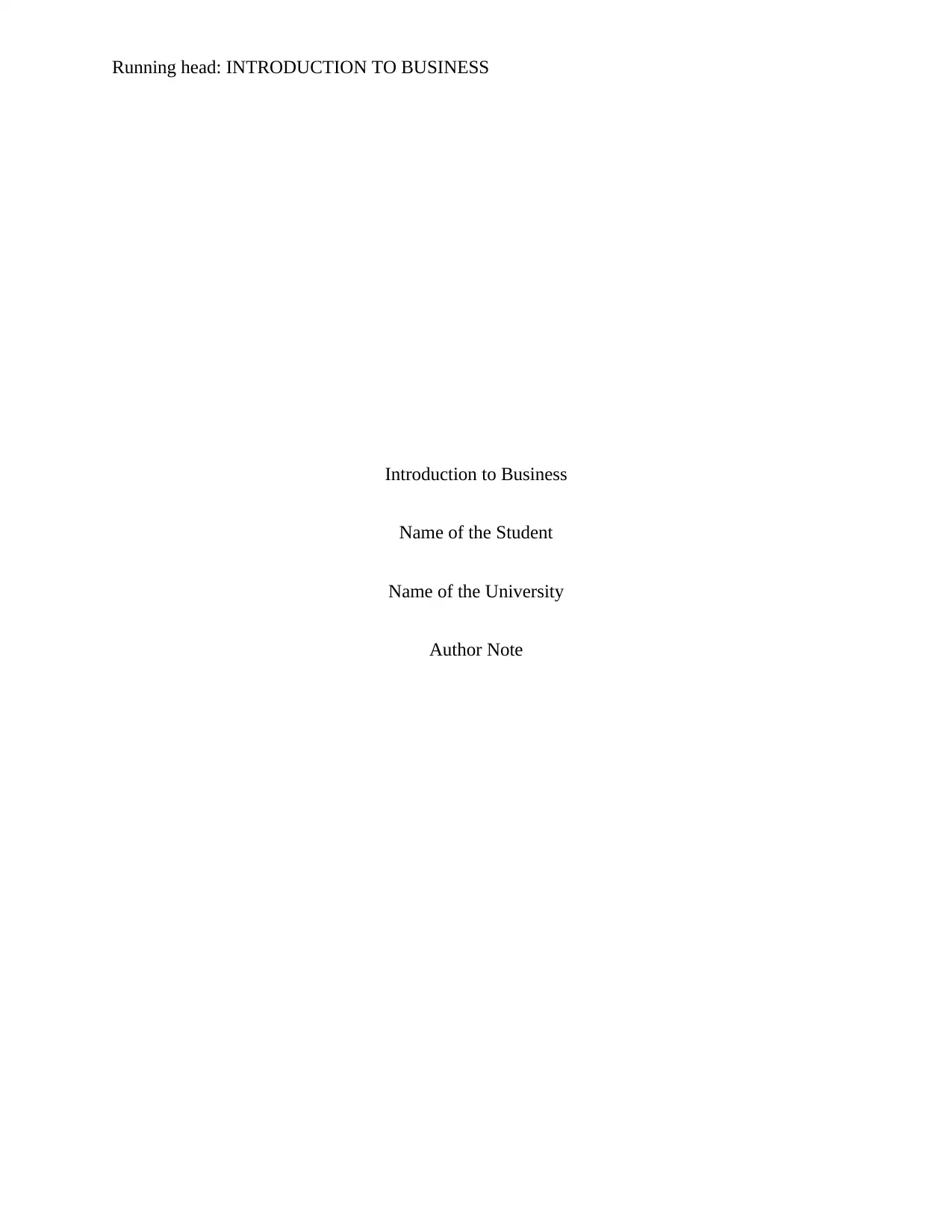
Running head: INTRODUCTION TO BUSINESS
Introduction to Business
Name of the Student
Name of the University
Author Note
Introduction to Business
Name of the Student
Name of the University
Author Note
Paraphrase This Document
Need a fresh take? Get an instant paraphrase of this document with our AI Paraphraser
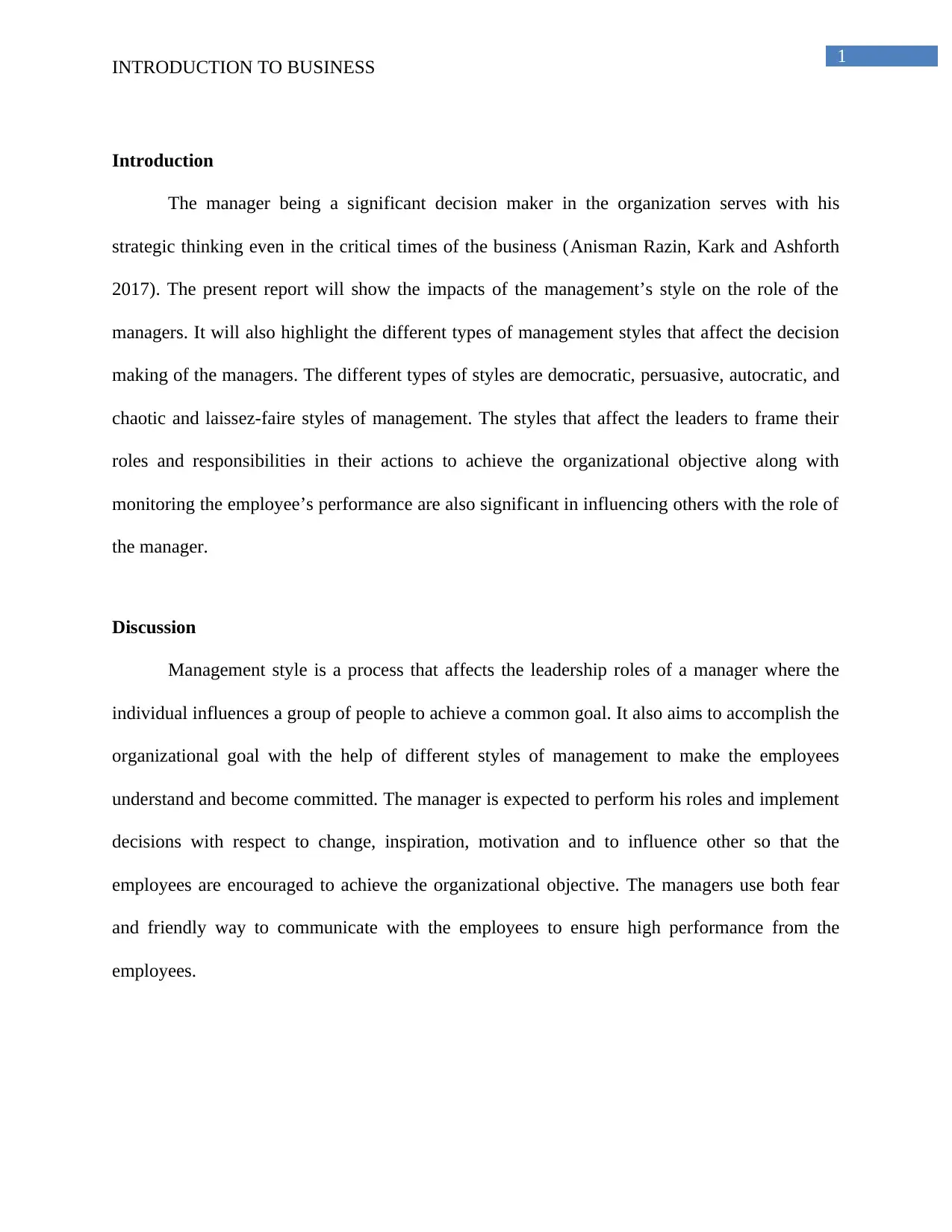
1
INTRODUCTION TO BUSINESS
Introduction
The manager being a significant decision maker in the organization serves with his
strategic thinking even in the critical times of the business (Anisman Razin, Kark and Ashforth
2017). The present report will show the impacts of the management’s style on the role of the
managers. It will also highlight the different types of management styles that affect the decision
making of the managers. The different types of styles are democratic, persuasive, autocratic, and
chaotic and laissez-faire styles of management. The styles that affect the leaders to frame their
roles and responsibilities in their actions to achieve the organizational objective along with
monitoring the employee’s performance are also significant in influencing others with the role of
the manager.
Discussion
Management style is a process that affects the leadership roles of a manager where the
individual influences a group of people to achieve a common goal. It also aims to accomplish the
organizational goal with the help of different styles of management to make the employees
understand and become committed. The manager is expected to perform his roles and implement
decisions with respect to change, inspiration, motivation and to influence other so that the
employees are encouraged to achieve the organizational objective. The managers use both fear
and friendly way to communicate with the employees to ensure high performance from the
employees.
INTRODUCTION TO BUSINESS
Introduction
The manager being a significant decision maker in the organization serves with his
strategic thinking even in the critical times of the business (Anisman Razin, Kark and Ashforth
2017). The present report will show the impacts of the management’s style on the role of the
managers. It will also highlight the different types of management styles that affect the decision
making of the managers. The different types of styles are democratic, persuasive, autocratic, and
chaotic and laissez-faire styles of management. The styles that affect the leaders to frame their
roles and responsibilities in their actions to achieve the organizational objective along with
monitoring the employee’s performance are also significant in influencing others with the role of
the manager.
Discussion
Management style is a process that affects the leadership roles of a manager where the
individual influences a group of people to achieve a common goal. It also aims to accomplish the
organizational goal with the help of different styles of management to make the employees
understand and become committed. The manager is expected to perform his roles and implement
decisions with respect to change, inspiration, motivation and to influence other so that the
employees are encouraged to achieve the organizational objective. The managers use both fear
and friendly way to communicate with the employees to ensure high performance from the
employees.
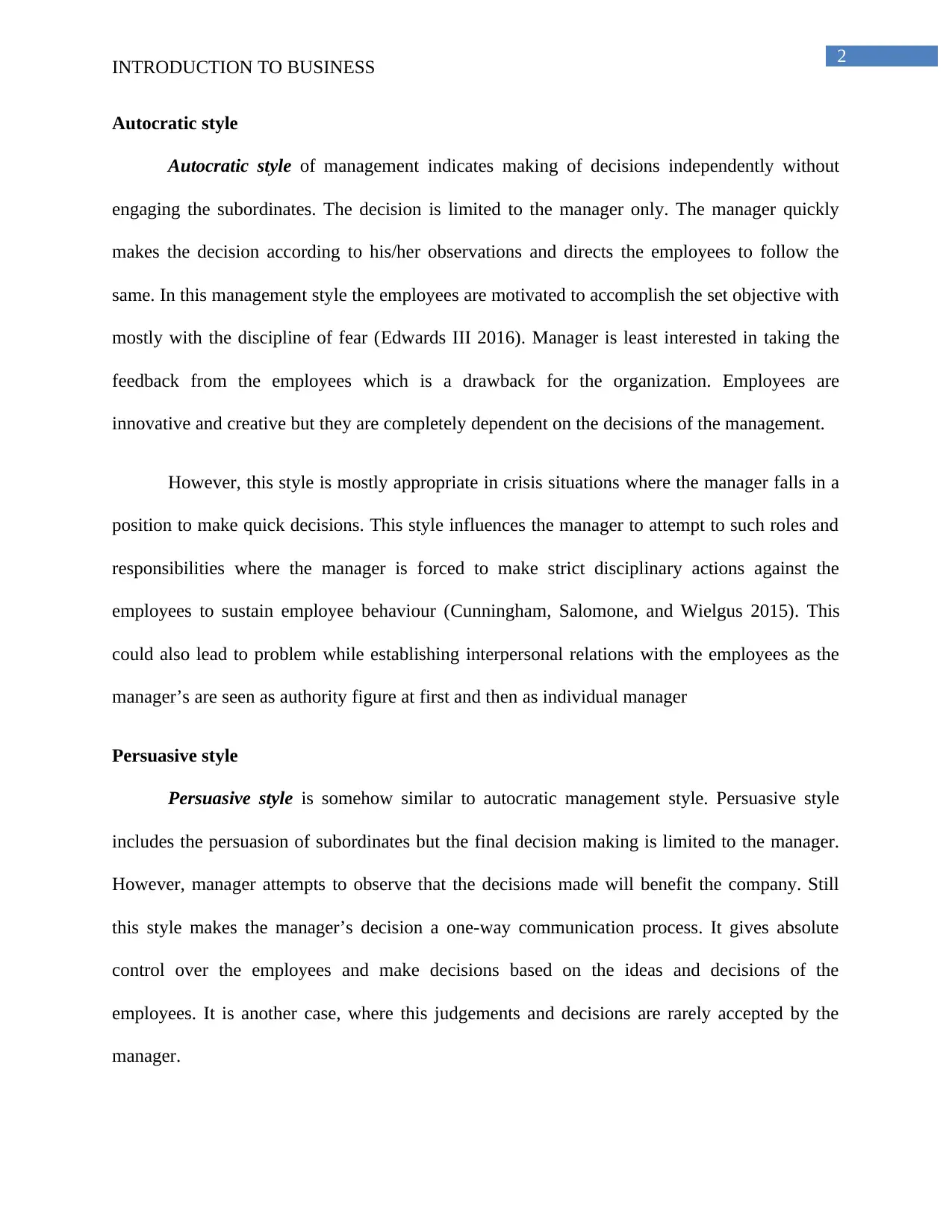
2
INTRODUCTION TO BUSINESS
Autocratic style
Autocratic style of management indicates making of decisions independently without
engaging the subordinates. The decision is limited to the manager only. The manager quickly
makes the decision according to his/her observations and directs the employees to follow the
same. In this management style the employees are motivated to accomplish the set objective with
mostly with the discipline of fear (Edwards III 2016). Manager is least interested in taking the
feedback from the employees which is a drawback for the organization. Employees are
innovative and creative but they are completely dependent on the decisions of the management.
However, this style is mostly appropriate in crisis situations where the manager falls in a
position to make quick decisions. This style influences the manager to attempt to such roles and
responsibilities where the manager is forced to make strict disciplinary actions against the
employees to sustain employee behaviour (Cunningham, Salomone, and Wielgus 2015). This
could also lead to problem while establishing interpersonal relations with the employees as the
manager’s are seen as authority figure at first and then as individual manager
Persuasive style
Persuasive style is somehow similar to autocratic management style. Persuasive style
includes the persuasion of subordinates but the final decision making is limited to the manager.
However, manager attempts to observe that the decisions made will benefit the company. Still
this style makes the manager’s decision a one-way communication process. It gives absolute
control over the employees and make decisions based on the ideas and decisions of the
employees. It is another case, where this judgements and decisions are rarely accepted by the
manager.
INTRODUCTION TO BUSINESS
Autocratic style
Autocratic style of management indicates making of decisions independently without
engaging the subordinates. The decision is limited to the manager only. The manager quickly
makes the decision according to his/her observations and directs the employees to follow the
same. In this management style the employees are motivated to accomplish the set objective with
mostly with the discipline of fear (Edwards III 2016). Manager is least interested in taking the
feedback from the employees which is a drawback for the organization. Employees are
innovative and creative but they are completely dependent on the decisions of the management.
However, this style is mostly appropriate in crisis situations where the manager falls in a
position to make quick decisions. This style influences the manager to attempt to such roles and
responsibilities where the manager is forced to make strict disciplinary actions against the
employees to sustain employee behaviour (Cunningham, Salomone, and Wielgus 2015). This
could also lead to problem while establishing interpersonal relations with the employees as the
manager’s are seen as authority figure at first and then as individual manager
Persuasive style
Persuasive style is somehow similar to autocratic management style. Persuasive style
includes the persuasion of subordinates but the final decision making is limited to the manager.
However, manager attempts to observe that the decisions made will benefit the company. Still
this style makes the manager’s decision a one-way communication process. It gives absolute
control over the employees and make decisions based on the ideas and decisions of the
employees. It is another case, where this judgements and decisions are rarely accepted by the
manager.
⊘ This is a preview!⊘
Do you want full access?
Subscribe today to unlock all pages.

Trusted by 1+ million students worldwide
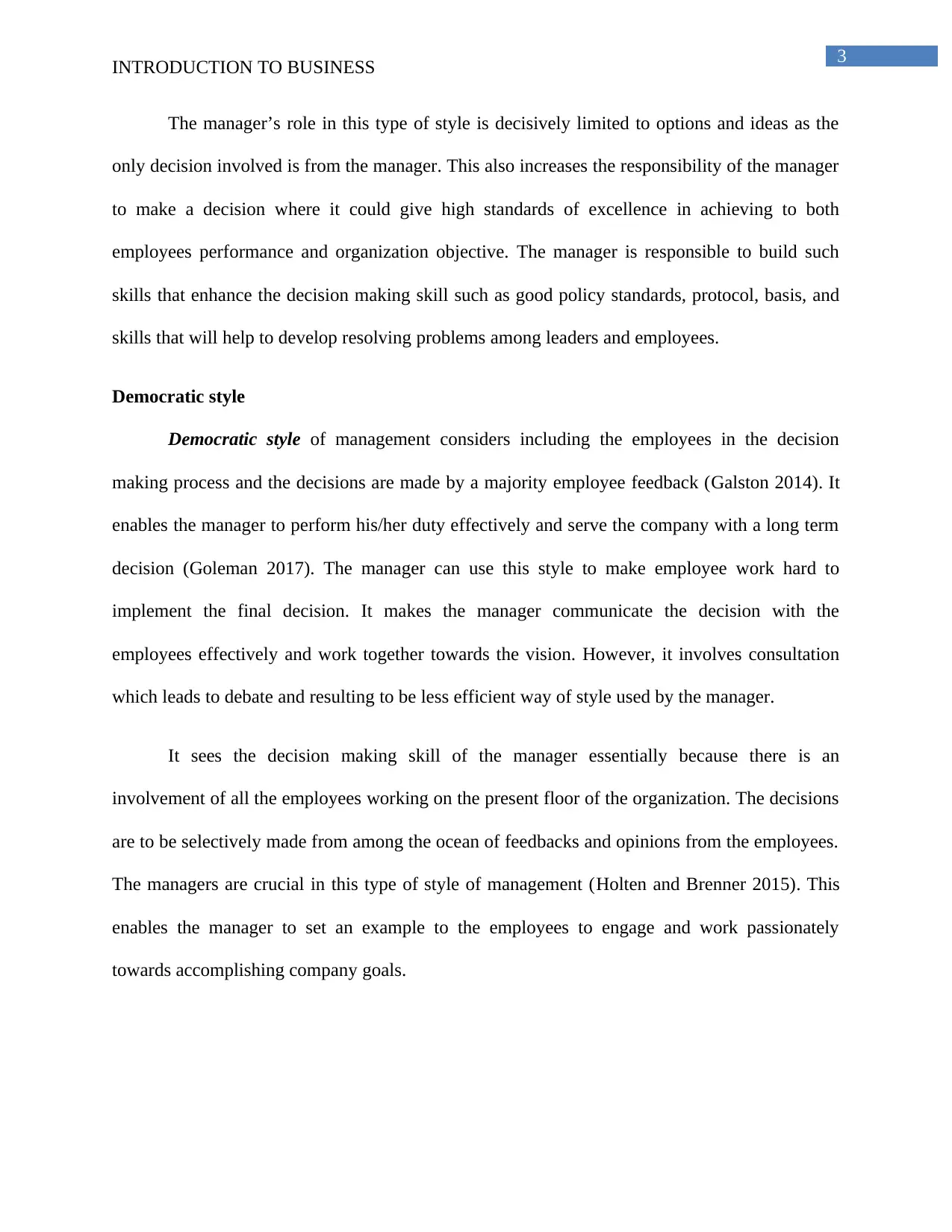
3
INTRODUCTION TO BUSINESS
The manager’s role in this type of style is decisively limited to options and ideas as the
only decision involved is from the manager. This also increases the responsibility of the manager
to make a decision where it could give high standards of excellence in achieving to both
employees performance and organization objective. The manager is responsible to build such
skills that enhance the decision making skill such as good policy standards, protocol, basis, and
skills that will help to develop resolving problems among leaders and employees.
Democratic style
Democratic style of management considers including the employees in the decision
making process and the decisions are made by a majority employee feedback (Galston 2014). It
enables the manager to perform his/her duty effectively and serve the company with a long term
decision (Goleman 2017). The manager can use this style to make employee work hard to
implement the final decision. It makes the manager communicate the decision with the
employees effectively and work together towards the vision. However, it involves consultation
which leads to debate and resulting to be less efficient way of style used by the manager.
It sees the decision making skill of the manager essentially because there is an
involvement of all the employees working on the present floor of the organization. The decisions
are to be selectively made from among the ocean of feedbacks and opinions from the employees.
The managers are crucial in this type of style of management (Holten and Brenner 2015). This
enables the manager to set an example to the employees to engage and work passionately
towards accomplishing company goals.
INTRODUCTION TO BUSINESS
The manager’s role in this type of style is decisively limited to options and ideas as the
only decision involved is from the manager. This also increases the responsibility of the manager
to make a decision where it could give high standards of excellence in achieving to both
employees performance and organization objective. The manager is responsible to build such
skills that enhance the decision making skill such as good policy standards, protocol, basis, and
skills that will help to develop resolving problems among leaders and employees.
Democratic style
Democratic style of management considers including the employees in the decision
making process and the decisions are made by a majority employee feedback (Galston 2014). It
enables the manager to perform his/her duty effectively and serve the company with a long term
decision (Goleman 2017). The manager can use this style to make employee work hard to
implement the final decision. It makes the manager communicate the decision with the
employees effectively and work together towards the vision. However, it involves consultation
which leads to debate and resulting to be less efficient way of style used by the manager.
It sees the decision making skill of the manager essentially because there is an
involvement of all the employees working on the present floor of the organization. The decisions
are to be selectively made from among the ocean of feedbacks and opinions from the employees.
The managers are crucial in this type of style of management (Holten and Brenner 2015). This
enables the manager to set an example to the employees to engage and work passionately
towards accomplishing company goals.
Paraphrase This Document
Need a fresh take? Get an instant paraphrase of this document with our AI Paraphraser
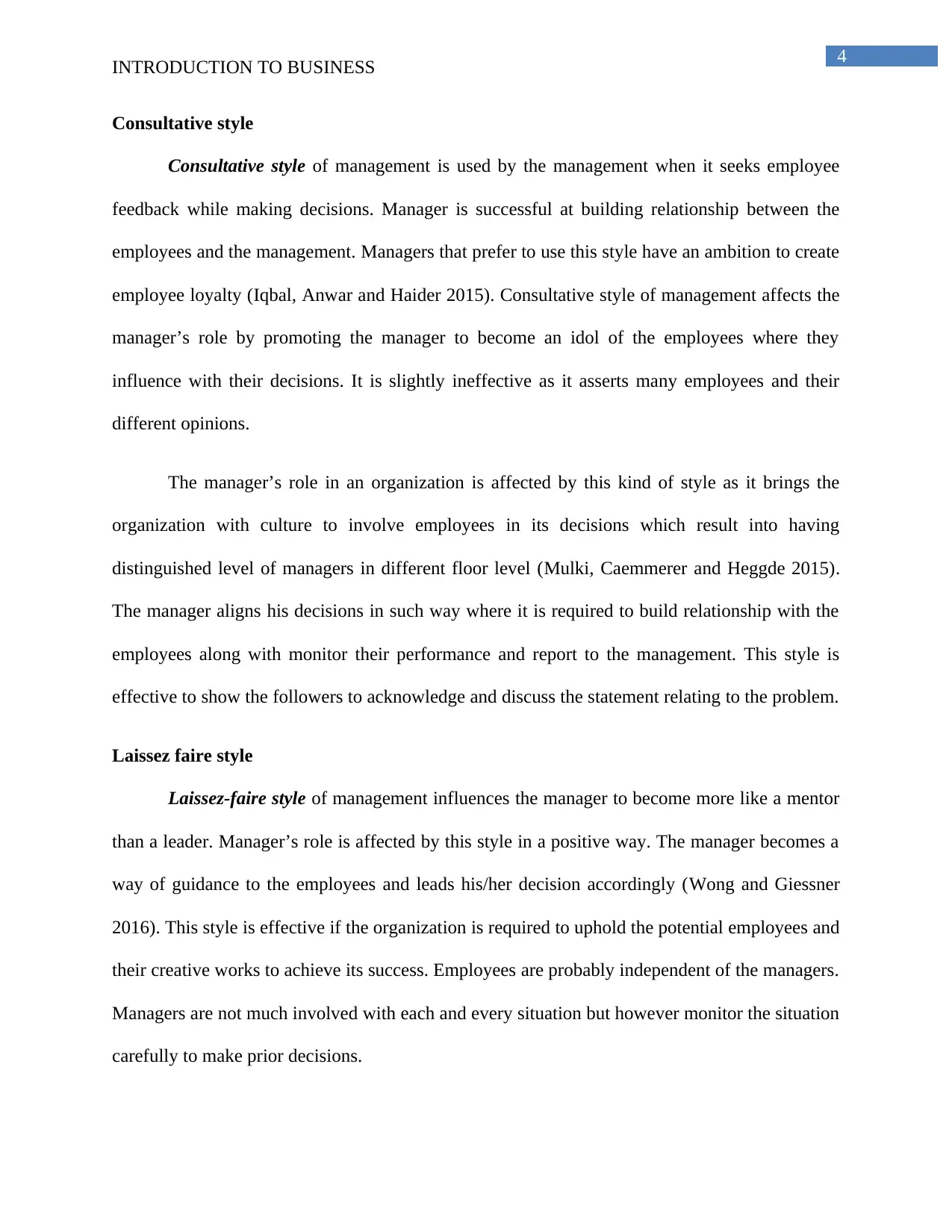
4
INTRODUCTION TO BUSINESS
Consultative style
Consultative style of management is used by the management when it seeks employee
feedback while making decisions. Manager is successful at building relationship between the
employees and the management. Managers that prefer to use this style have an ambition to create
employee loyalty (Iqbal, Anwar and Haider 2015). Consultative style of management affects the
manager’s role by promoting the manager to become an idol of the employees where they
influence with their decisions. It is slightly ineffective as it asserts many employees and their
different opinions.
The manager’s role in an organization is affected by this kind of style as it brings the
organization with culture to involve employees in its decisions which result into having
distinguished level of managers in different floor level (Mulki, Caemmerer and Heggde 2015).
The manager aligns his decisions in such way where it is required to build relationship with the
employees along with monitor their performance and report to the management. This style is
effective to show the followers to acknowledge and discuss the statement relating to the problem.
Laissez faire style
Laissez-faire style of management influences the manager to become more like a mentor
than a leader. Manager’s role is affected by this style in a positive way. The manager becomes a
way of guidance to the employees and leads his/her decision accordingly (Wong and Giessner
2016). This style is effective if the organization is required to uphold the potential employees and
their creative works to achieve its success. Employees are probably independent of the managers.
Managers are not much involved with each and every situation but however monitor the situation
carefully to make prior decisions.
INTRODUCTION TO BUSINESS
Consultative style
Consultative style of management is used by the management when it seeks employee
feedback while making decisions. Manager is successful at building relationship between the
employees and the management. Managers that prefer to use this style have an ambition to create
employee loyalty (Iqbal, Anwar and Haider 2015). Consultative style of management affects the
manager’s role by promoting the manager to become an idol of the employees where they
influence with their decisions. It is slightly ineffective as it asserts many employees and their
different opinions.
The manager’s role in an organization is affected by this kind of style as it brings the
organization with culture to involve employees in its decisions which result into having
distinguished level of managers in different floor level (Mulki, Caemmerer and Heggde 2015).
The manager aligns his decisions in such way where it is required to build relationship with the
employees along with monitor their performance and report to the management. This style is
effective to show the followers to acknowledge and discuss the statement relating to the problem.
Laissez faire style
Laissez-faire style of management influences the manager to become more like a mentor
than a leader. Manager’s role is affected by this style in a positive way. The manager becomes a
way of guidance to the employees and leads his/her decision accordingly (Wong and Giessner
2016). This style is effective if the organization is required to uphold the potential employees and
their creative works to achieve its success. Employees are probably independent of the managers.
Managers are not much involved with each and every situation but however monitor the situation
carefully to make prior decisions.
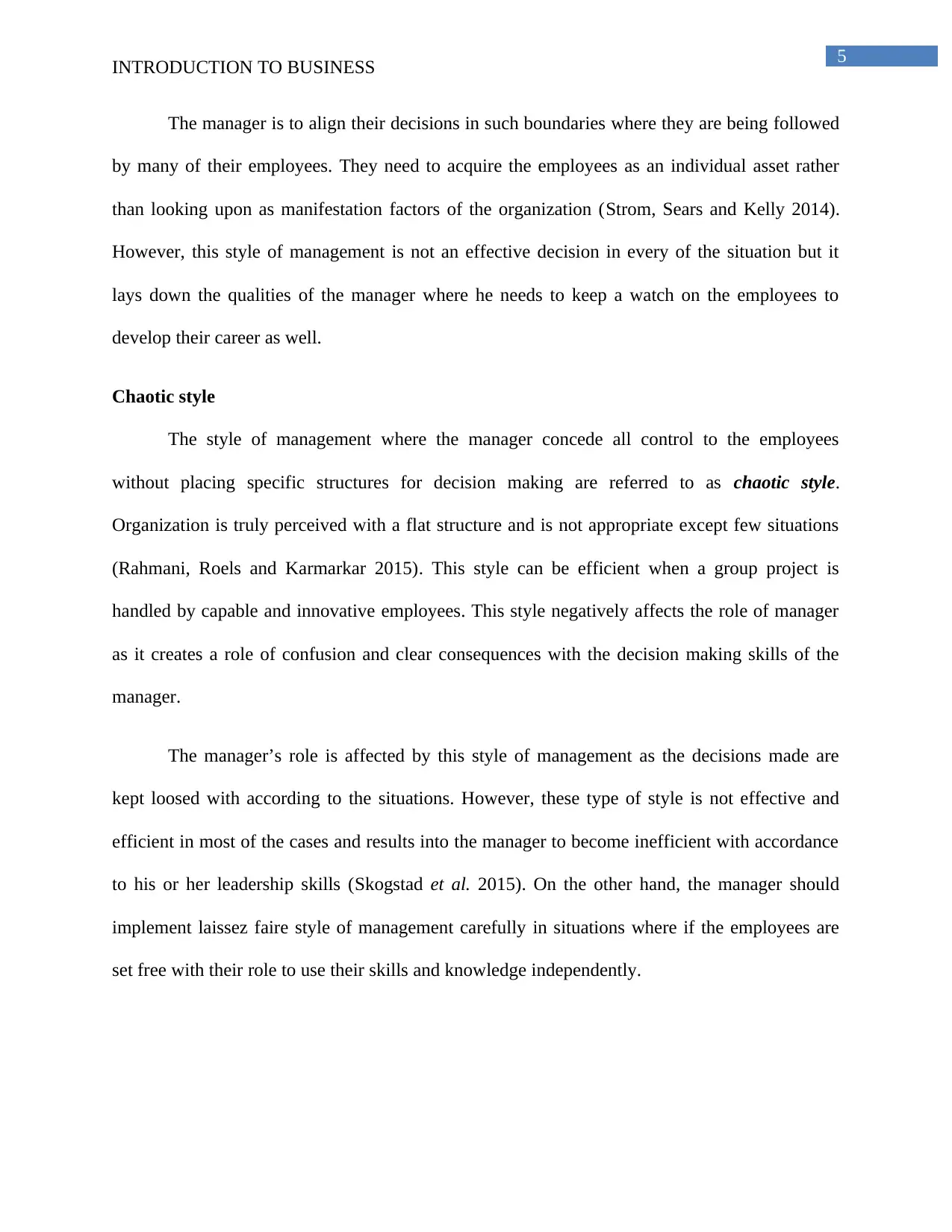
5
INTRODUCTION TO BUSINESS
The manager is to align their decisions in such boundaries where they are being followed
by many of their employees. They need to acquire the employees as an individual asset rather
than looking upon as manifestation factors of the organization (Strom, Sears and Kelly 2014).
However, this style of management is not an effective decision in every of the situation but it
lays down the qualities of the manager where he needs to keep a watch on the employees to
develop their career as well.
Chaotic style
The style of management where the manager concede all control to the employees
without placing specific structures for decision making are referred to as chaotic style.
Organization is truly perceived with a flat structure and is not appropriate except few situations
(Rahmani, Roels and Karmarkar 2015). This style can be efficient when a group project is
handled by capable and innovative employees. This style negatively affects the role of manager
as it creates a role of confusion and clear consequences with the decision making skills of the
manager.
The manager’s role is affected by this style of management as the decisions made are
kept loosed with according to the situations. However, these type of style is not effective and
efficient in most of the cases and results into the manager to become inefficient with accordance
to his or her leadership skills (Skogstad et al. 2015). On the other hand, the manager should
implement laissez faire style of management carefully in situations where if the employees are
set free with their role to use their skills and knowledge independently.
INTRODUCTION TO BUSINESS
The manager is to align their decisions in such boundaries where they are being followed
by many of their employees. They need to acquire the employees as an individual asset rather
than looking upon as manifestation factors of the organization (Strom, Sears and Kelly 2014).
However, this style of management is not an effective decision in every of the situation but it
lays down the qualities of the manager where he needs to keep a watch on the employees to
develop their career as well.
Chaotic style
The style of management where the manager concede all control to the employees
without placing specific structures for decision making are referred to as chaotic style.
Organization is truly perceived with a flat structure and is not appropriate except few situations
(Rahmani, Roels and Karmarkar 2015). This style can be efficient when a group project is
handled by capable and innovative employees. This style negatively affects the role of manager
as it creates a role of confusion and clear consequences with the decision making skills of the
manager.
The manager’s role is affected by this style of management as the decisions made are
kept loosed with according to the situations. However, these type of style is not effective and
efficient in most of the cases and results into the manager to become inefficient with accordance
to his or her leadership skills (Skogstad et al. 2015). On the other hand, the manager should
implement laissez faire style of management carefully in situations where if the employees are
set free with their role to use their skills and knowledge independently.
⊘ This is a preview!⊘
Do you want full access?
Subscribe today to unlock all pages.

Trusted by 1+ million students worldwide
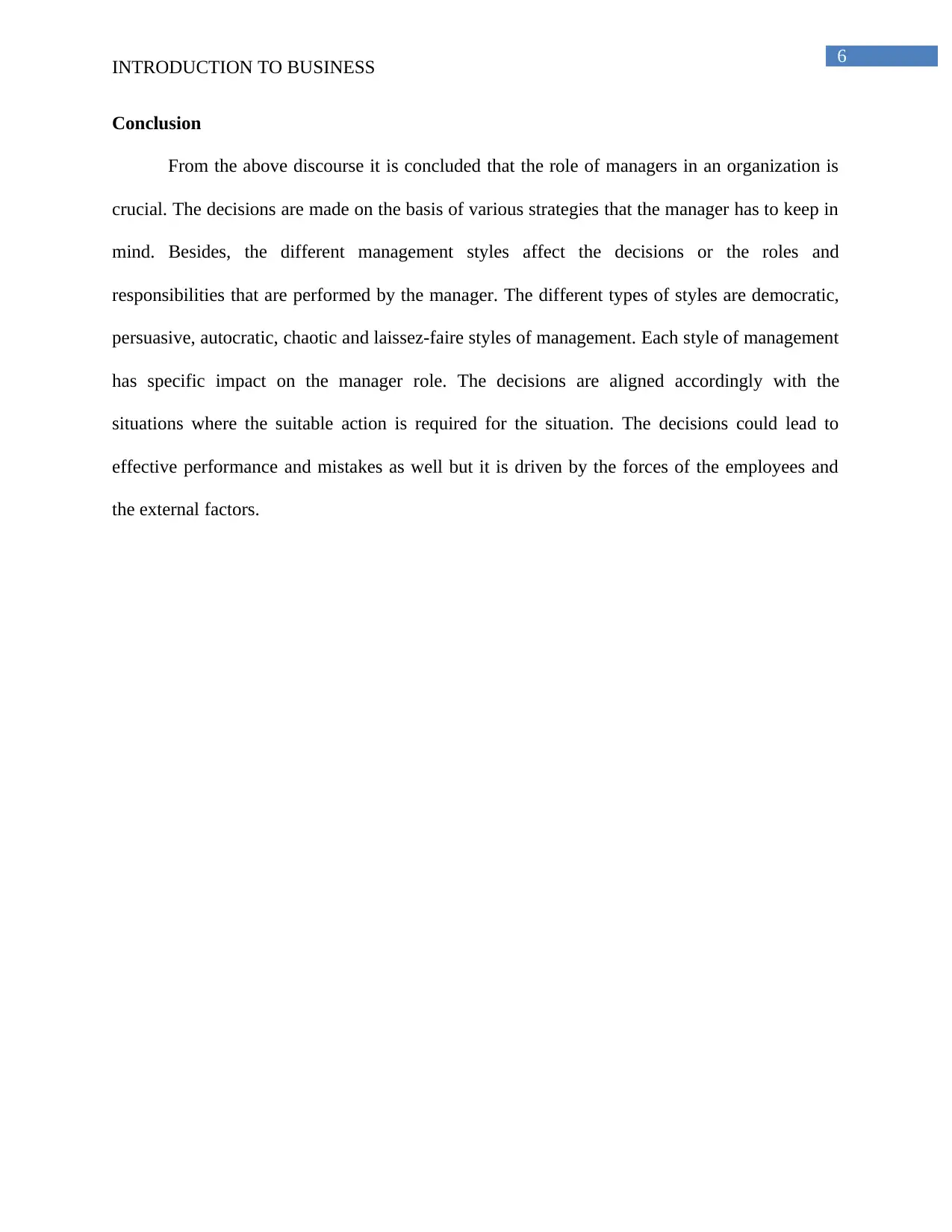
6
INTRODUCTION TO BUSINESS
Conclusion
From the above discourse it is concluded that the role of managers in an organization is
crucial. The decisions are made on the basis of various strategies that the manager has to keep in
mind. Besides, the different management styles affect the decisions or the roles and
responsibilities that are performed by the manager. The different types of styles are democratic,
persuasive, autocratic, chaotic and laissez-faire styles of management. Each style of management
has specific impact on the manager role. The decisions are aligned accordingly with the
situations where the suitable action is required for the situation. The decisions could lead to
effective performance and mistakes as well but it is driven by the forces of the employees and
the external factors.
INTRODUCTION TO BUSINESS
Conclusion
From the above discourse it is concluded that the role of managers in an organization is
crucial. The decisions are made on the basis of various strategies that the manager has to keep in
mind. Besides, the different management styles affect the decisions or the roles and
responsibilities that are performed by the manager. The different types of styles are democratic,
persuasive, autocratic, chaotic and laissez-faire styles of management. Each style of management
has specific impact on the manager role. The decisions are aligned accordingly with the
situations where the suitable action is required for the situation. The decisions could lead to
effective performance and mistakes as well but it is driven by the forces of the employees and
the external factors.
Paraphrase This Document
Need a fresh take? Get an instant paraphrase of this document with our AI Paraphraser
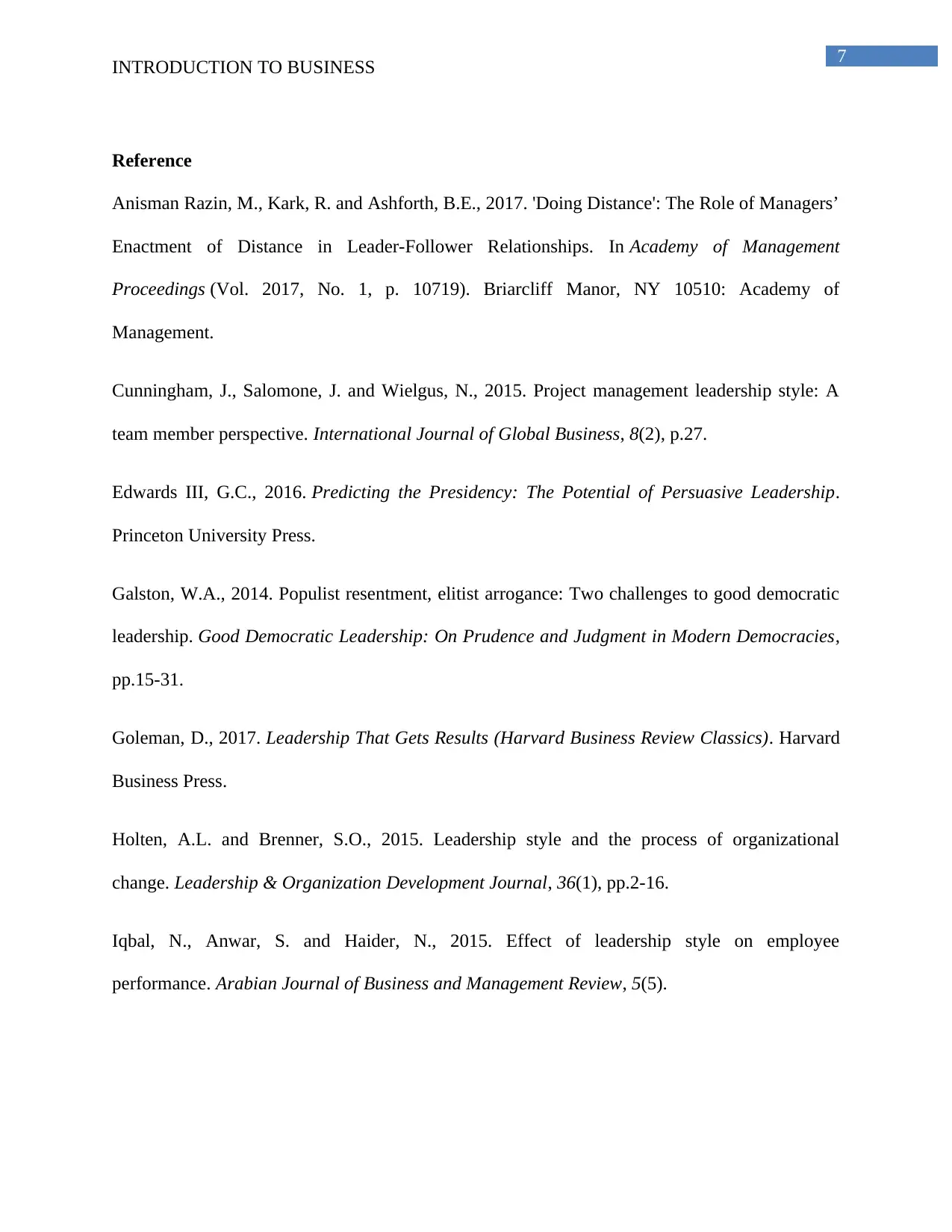
7
INTRODUCTION TO BUSINESS
Reference
Anisman Razin, M., Kark, R. and Ashforth, B.E., 2017. 'Doing Distance': The Role of Managers’
Enactment of Distance in Leader-Follower Relationships. In Academy of Management
Proceedings (Vol. 2017, No. 1, p. 10719). Briarcliff Manor, NY 10510: Academy of
Management.
Cunningham, J., Salomone, J. and Wielgus, N., 2015. Project management leadership style: A
team member perspective. International Journal of Global Business, 8(2), p.27.
Edwards III, G.C., 2016. Predicting the Presidency: The Potential of Persuasive Leadership.
Princeton University Press.
Galston, W.A., 2014. Populist resentment, elitist arrogance: Two challenges to good democratic
leadership. Good Democratic Leadership: On Prudence and Judgment in Modern Democracies,
pp.15-31.
Goleman, D., 2017. Leadership That Gets Results (Harvard Business Review Classics). Harvard
Business Press.
Holten, A.L. and Brenner, S.O., 2015. Leadership style and the process of organizational
change. Leadership & Organization Development Journal, 36(1), pp.2-16.
Iqbal, N., Anwar, S. and Haider, N., 2015. Effect of leadership style on employee
performance. Arabian Journal of Business and Management Review, 5(5).
INTRODUCTION TO BUSINESS
Reference
Anisman Razin, M., Kark, R. and Ashforth, B.E., 2017. 'Doing Distance': The Role of Managers’
Enactment of Distance in Leader-Follower Relationships. In Academy of Management
Proceedings (Vol. 2017, No. 1, p. 10719). Briarcliff Manor, NY 10510: Academy of
Management.
Cunningham, J., Salomone, J. and Wielgus, N., 2015. Project management leadership style: A
team member perspective. International Journal of Global Business, 8(2), p.27.
Edwards III, G.C., 2016. Predicting the Presidency: The Potential of Persuasive Leadership.
Princeton University Press.
Galston, W.A., 2014. Populist resentment, elitist arrogance: Two challenges to good democratic
leadership. Good Democratic Leadership: On Prudence and Judgment in Modern Democracies,
pp.15-31.
Goleman, D., 2017. Leadership That Gets Results (Harvard Business Review Classics). Harvard
Business Press.
Holten, A.L. and Brenner, S.O., 2015. Leadership style and the process of organizational
change. Leadership & Organization Development Journal, 36(1), pp.2-16.
Iqbal, N., Anwar, S. and Haider, N., 2015. Effect of leadership style on employee
performance. Arabian Journal of Business and Management Review, 5(5).
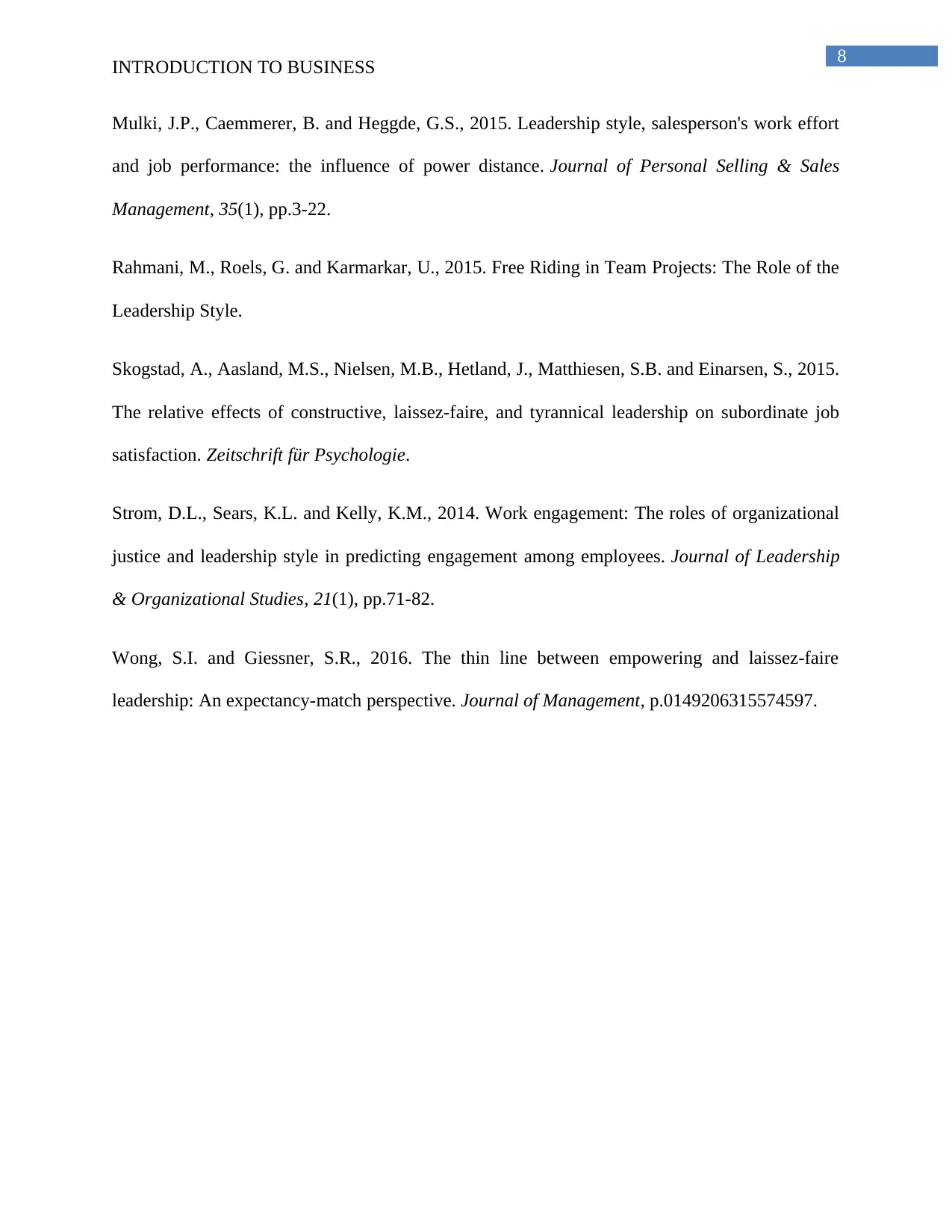
8
INTRODUCTION TO BUSINESS
Mulki, J.P., Caemmerer, B. and Heggde, G.S., 2015. Leadership style, salesperson's work effort
and job performance: the influence of power distance. Journal of Personal Selling & Sales
Management, 35(1), pp.3-22.
Rahmani, M., Roels, G. and Karmarkar, U., 2015. Free Riding in Team Projects: The Role of the
Leadership Style.
Skogstad, A., Aasland, M.S., Nielsen, M.B., Hetland, J., Matthiesen, S.B. and Einarsen, S., 2015.
The relative effects of constructive, laissez-faire, and tyrannical leadership on subordinate job
satisfaction. Zeitschrift für Psychologie.
Strom, D.L., Sears, K.L. and Kelly, K.M., 2014. Work engagement: The roles of organizational
justice and leadership style in predicting engagement among employees. Journal of Leadership
& Organizational Studies, 21(1), pp.71-82.
Wong, S.I. and Giessner, S.R., 2016. The thin line between empowering and laissez-faire
leadership: An expectancy-match perspective. Journal of Management, p.0149206315574597.
INTRODUCTION TO BUSINESS
Mulki, J.P., Caemmerer, B. and Heggde, G.S., 2015. Leadership style, salesperson's work effort
and job performance: the influence of power distance. Journal of Personal Selling & Sales
Management, 35(1), pp.3-22.
Rahmani, M., Roels, G. and Karmarkar, U., 2015. Free Riding in Team Projects: The Role of the
Leadership Style.
Skogstad, A., Aasland, M.S., Nielsen, M.B., Hetland, J., Matthiesen, S.B. and Einarsen, S., 2015.
The relative effects of constructive, laissez-faire, and tyrannical leadership on subordinate job
satisfaction. Zeitschrift für Psychologie.
Strom, D.L., Sears, K.L. and Kelly, K.M., 2014. Work engagement: The roles of organizational
justice and leadership style in predicting engagement among employees. Journal of Leadership
& Organizational Studies, 21(1), pp.71-82.
Wong, S.I. and Giessner, S.R., 2016. The thin line between empowering and laissez-faire
leadership: An expectancy-match perspective. Journal of Management, p.0149206315574597.
⊘ This is a preview!⊘
Do you want full access?
Subscribe today to unlock all pages.

Trusted by 1+ million students worldwide
1 out of 9
Related Documents
Your All-in-One AI-Powered Toolkit for Academic Success.
+13062052269
info@desklib.com
Available 24*7 on WhatsApp / Email
![[object Object]](/_next/static/media/star-bottom.7253800d.svg)
Unlock your academic potential
Copyright © 2020–2025 A2Z Services. All Rights Reserved. Developed and managed by ZUCOL.





